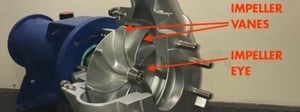
What is a centrifugal pump and how does it work?
Centrifugal pumps rely upon as an industry workhorse since the 17th century. These are the most commonly used type of pump for the transfer of liquids.
A centrifugal pump operates through a rotating impeller within a casing that is usually driven by an electric motor or petrol / diesel engine. The centrifugal pump converts rotational kinetic energy from the driver to the hydrodynamic energy of the fluid flow.
Fluid enters through the inlet of the pump and into the eye of the impeller. As the impeller rotates, the liquid accelerates radially between the vanes. This gains both velocity and pressure until it exits at the outside diameter. Then directed to the pump outlet by the volute casing. As the liquid discharges from the casing, the flow velocity reduces, and discharge pressure increased.
Centrifugal pumps are the ideal solution for any transfer of liquids. Especially when higher flowrates are required or pumping solids laden liquids.
At Crest Pumps we have nearly 50 years’ experience to recommend the best pump for your corrosive requirements, so please get in touch.
We often post articles and other news on our LinkedIn page so please go and follow to keep up to date or for any pump queries you may have please contact us.






